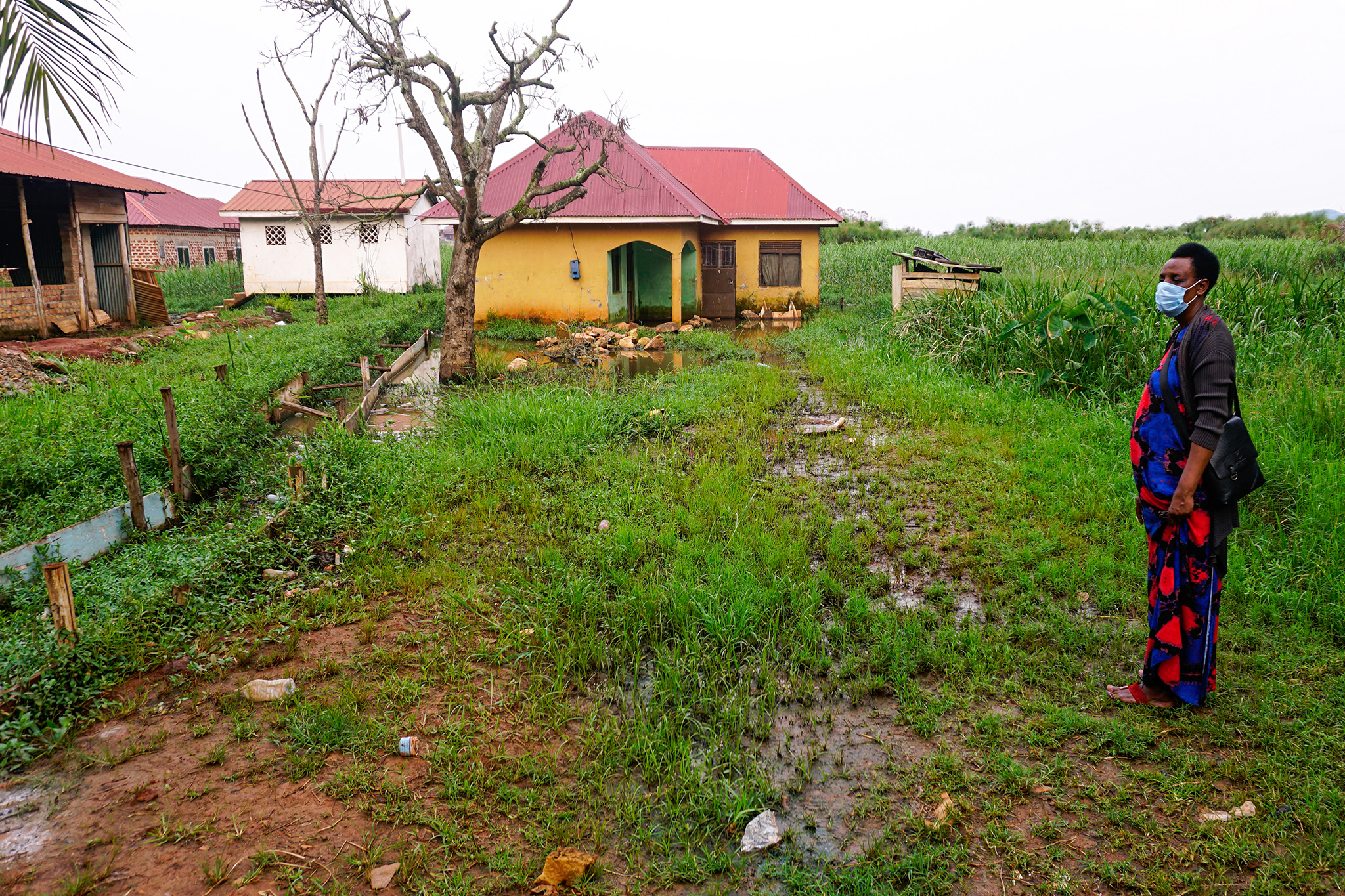
Edna Namara, GPJ Uganda
Betty Kyasiimire, a resident of Kampala, stands by her flooded house near Lake Victoria.
KIKUUBE, UGANDA — Standing on the shore of Lake Albert, on Uganda’s western border, Sanyu Sanday looks out past the surf to where her small mud house stands partially submerged in the water. She’s salvaged what she can — her mattress and other possessions sit on a small motorboat — but after living on the lakeshore for the past two years, she’s unsure about where she will go.
“The raging waters have cut us off from what we knew as home,” Sanyu says.
Severe flooding has stricken Uganda in recent years, as changing weather patterns have led to increased rainfall, causing lakes and rivers to swell. Hundreds of thousands of people have been displaced across the country, particularly in flood-prone areas surrounding Lake Victoria to the south, Lake Albert to the west, and Lake Kyoga in the center of the country. It’s a situation that is likely to become worse as global temperatures rise and people continue to destroy Uganda’s wetlands to build roads, houses and other infrastructure.
Since October 2019, rising temperatures in the Indian Ocean have led to intense and prolonged rainfall in Uganda, causing water levels in Lake Victoria, one of Africa’s Great Lakes, to reach historic highs not seen since the 1960s. This has caused extreme flooding in the Lake Victoria basin.
“Too much rain means too much collected in the basin, which overspills and floods neighboring places,” says George William Omony, a senior meteorologist at the Uganda National Meteorological Authority.



The government has been working to relocate thousands impacted by the flooding. But people like Sanyu, who built homes in parts of the Lake Victoria basin without obtaining official authorization, haven’t been included in these resettlement plans, according to Jackson Twinomujuni, commissioner of International and Transboundary Water Affairs at the Ministry of Water and Environment.
Achidria Tony, a spokesperson for the National Environment Management Authority, says that while the government can’t stop climate change or the increased rainfall it brings, officials are trying to prepare for rising water levels.
“What we do is ensure natural flood control systems such as wetlands and forests are not degraded and are instead used sustainably,” he says.
Decades ago, Uganda’s wetlands were able to absorb such flooding. But infrastructure development has caused the country’s wetlands to dwindle — from 32,000 square kilometers (12,355 square miles) in 1964 down to 26,308 square kilometers (10,158 square miles) as of 2005, according to the Ministry of Water and Environment.
“In 1961, 1964, the water was contained without alarm, because there was enough forest cover and swamps,” says Twinomujuni, referring to the historic rainfall Uganda experienced in the 1960s. “There were no paved homes and drainage channels, which do not retain any rainwater, but leave it with the only alternative to flow into the lake, hence the rise.”



Rising water is a problem in Uganda’s capital city of Kampala as well. Annual damages from flooding, which were less than $10 million in 2013, could increase to between $33 million and $102 million by 2050, according to a report by Wilson Truman Okaka, a lecturer at Kyambogo University in Kampala, who researches climate change.
In 2014, Nankya Amina built a house with rental units in a wetland area within the city’s Makindye division, along the shores of Lake Victoria. She hoped to generate income to help support herself and her six children. By law, property owners must obtain authorization from the National Environment Management Authority before they can build. But Nankya didn’t submit her plans for approval.
“I knew environmentalists would not approve my plot, since it was in the wetland,” Nankya says. “Also, I did not want to spend my money on processing the plan.”
Now she regrets the decision. The ground floor of the house is submerged in water and continues to sink, forcing her to live in a small wooden structure nearby. Even this living situation may be temporary.
“Nankya and 385 households in Makindye West division have to relocate and give back the water its territory,” says Achidria. “We sent out early warnings telling them to move before the floods.”
Sanyu, for her part, has grown accustomed to being uprooted. She initially came to Uganda in 2018 after fleeing violence in her native Democratic Republic of Congo, just across Lake Albert. She has been living in Uganda without legal documents, making money by catching and selling fish, while taking periodic trips back to DRC to check on her aging mother.
She had hoped to remain in the area and find employment cooking for workers coming to labor in the nearby oil fields. With her home destroyed, that future is now in doubt.
“We are turned double refugees,” Sanyu says, “unable to sit in either the host or mother country.”
Edna Namara is a Global Press Journal reporter based in Kampala, Uganda. She specializes in reporting about power and bodily autonomy.







